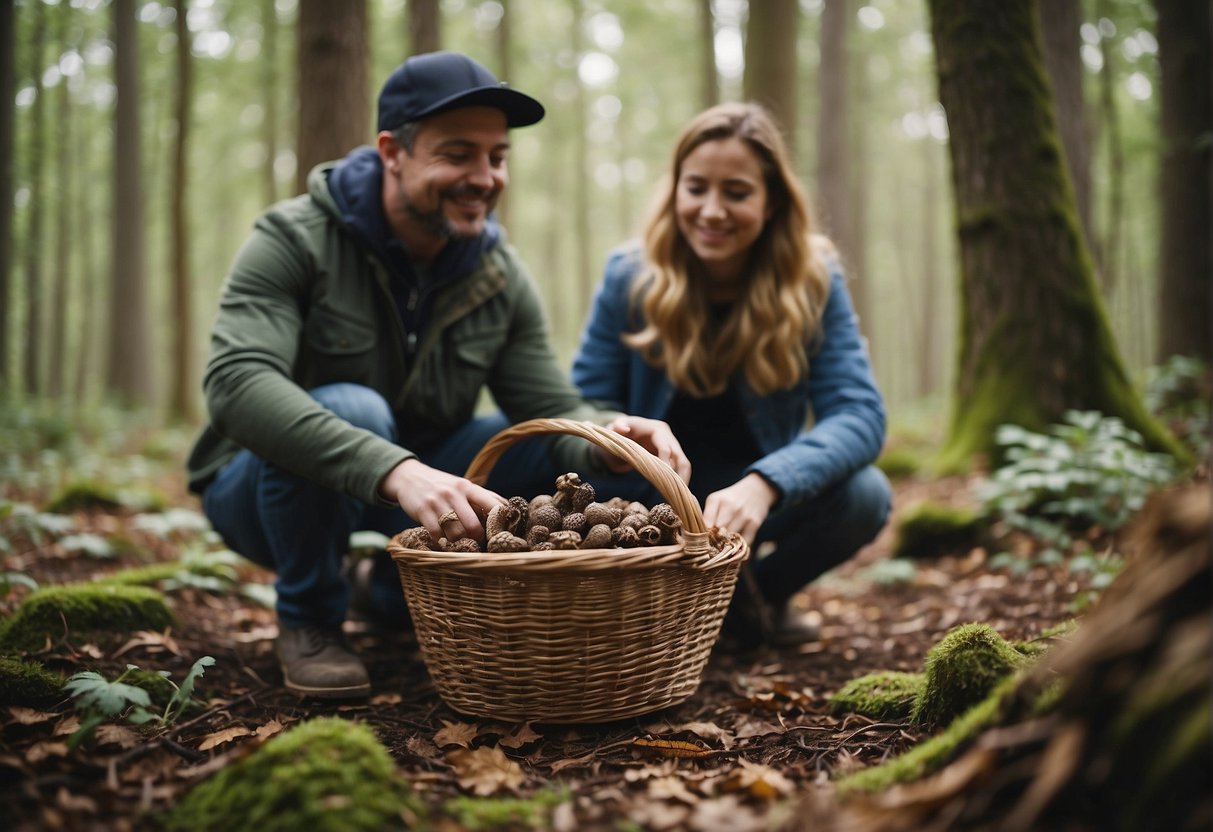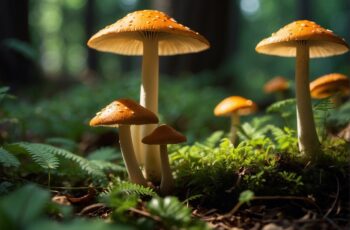Embarking on the quest for morel mushrooms is a springtime tradition for many outdoors enthusiasts. As the soil warms and early spring showers moisten the earth, these elusive and highly prized fungi make their brief appearance. The thrill of the hunt is as much a part of the experience as the reward of finding these spongy, cone-shaped delights. Knowledge about their preferred conditions and habitats serves as your treasure map, guiding you through forests and fields in search of the perfect morel hotspot.
Understanding the nuances of morel mushroom ecology can significantly increase your chances of a bountiful harvest. These fungi have a symbiotic relationship with certain trees and thrive in specific soil types, making location scouting a critical step. It’s also the time to engage with the mushroom hunting community; their shared experiences and wisdom can lead to new and fruitful hunting grounds. With respect for nature and a responsible approach to foraging, you’ll not only enjoy this seasonal activity but also ensure that these natural treasures continue to flourish for years to come.
Key Takeaways
- Morel hunting is a rewarding spring activity that combines the joys of foraging with an appreciation for nature.
- Knowing the ecological preferences of morels is key to successful mushroom hunting expeditions.
- Participating in the morel hunting community can enhance your foraging knowledge and success.
Understanding Morel Mushroom Ecology
Grasping the ecology of morel mushrooms involves recognizing how they interact with their environment. It’s crucial to know where to find them, understand the conditions they thrive in, and have insight into their unique lifecycle.
Typical Habitats and Trees
Morel mushrooms tend to favor hardwood forests as they have a symbiotic relationship with certain trees. Focus your search around ash, elm, sycamore, and apple orchards. These environments are particularly conducive to morel growth, especially in areas where there might be decaying trees or a recent burn.
- Ash Trees: Well-known for being associated with morel growth.
- Elm and Sycamore: Look for standing dead or dying trees.
- Apple Orchards: Older orchards can be hot spots if pesticides aren’t used.
Remember to also check river bottoms; morels find these areas suitable due to the moist soil conditions.
Soil and Weather Conditions
Successful morel hunters pay close attention to soil temperature and weather patterns. Morels need soil temperatures to be around 45 to 60 degrees Fahrenheit, which often correlates with the flowering of certain plants.
- Soil Temperature: Invest in a soil thermometer or check local soil temperature reports.
- Rainfall: Adequate rain is vital, as too much or too little can affect morel growth.
- Permeable Soils: Sandy and loamy soils allow for proper moisture and air flow.
By monitoring the local weather forecast and keeping an eye on temperature shifts, you can predict potential morel growth.
Lifecycle and Spore Dispersal
Understanding a morel’s lifecycle is paramount, from when the spores are released to when the mushrooms mature and are ready to harvest. Morels release spores in late spring through summer, which spread to create new growth areas for following seasons.
- Lifecycle Stages:
- Germination: Starts once the spores meet the right conditions.
- Mycelium Growth: The underground network that prefaces mushrooms.
- Fruiting: Visible morel mushrooms emerge after the mycelium is well-established.
Focus on areas with oak leaves and decaying wood, which provide organic material needed for spores to develop into the mycelium. Keep in mind that morels are part of a delicate ecosystem and practice sustainable foraging to avoid disrupting their lifecycle.
Best Practices for Morel Mushroom Hunting
Successful morel mushroom hunting hinges on timing, understanding the ideal environments where morels thrive, and prioritizing safety through accurate identification.
When to Hunt
Morel mushrooms flourish in specific conditions; you’ll find the best success when the ground temperature reaches about 50 degrees. This typically occurs in spring, sometimes aligning with turkey season in regions like the Upper Midwest and Great Plains. Hunt after a rain when the soil is moist and daytime temperatures are between 60 and 70 degrees Fahrenheit.
Where to Look
Morels favor certain habitats:
- South-facing slopes, which warm up first in spring.
- Near the bases of certain trees, with a preference for elm, tulip poplar, and other dying trees.
- Burn areas of forests, where morels can appear prolifically in the year following a fire.
- River valleys and bottoms, indicative of necessary moisture levels.
Be mindful of legal restrictions on private land; always gain permission before hunting.
Safety and Identification
Accurate identification is crucial to ensure you harvest true morels and avoid the toxic false morel. Carry a field guide or use a reliable app to compare features.
- Morels have hollow stems; false ones are often solid or cottony inside.
- Use a mushroom hunter‘s guide to differentiate between varieties.
Remember, maintaining the integrity of the forest and its resources is paramount; always practice sustainable harvesting techniques.
Harvesting and Preserving Morels
In the world of foraging, morels are a coveted prize known for their unique flavor. Navigating the art of harvesting and preserving morels is essential to enjoying these seasonal delights all year round.
Collecting and Transporting
When you’re out in the woods after a snowmelt or a spring rain, keep an eye on the morel mushroom map to improve your chances of finding these treasures. Once you spot a morel, cut the stem at ground level to avoid pulling out the root-like structure. Transport your fresh finds in a mesh bag; this allows any spores to disperse, promoting regrowth in the area.
- Mesh Bag: Allows spore dispersal
- Cut: Stem at ground level
Cleaning and Storage
Back home, it’s time to clean your morels thoroughly to remove any bugs or worms. Gently wash them with a brush and cold water, and then soak them in a salt water solution briefly to evict any stubborn critters. For storage, you have two options: dry them in the shade or freeze them for later use.
- Wash: Cold water and a brush
- Dry: In the shade or a dehydrator
- Freeze: In airtight containers
Preparation for Consumption
To get your morels ready for the kitchen, wash them again quickly under cold water if they’ve been dried. If you’re about to cook them fresh, batter and fry them up or sauté to firm their texture. Remember to cook your morels completely to avoid any potential health concerns related to consuming them raw.
- Fresh: Batter and fry for a crispy treat
- Dried: Rehydrate briefly under cold water before cooking
Culinary Applications of Morels
Morel mushrooms, revered for their deep and earthy flavor, offer a range of culinary uses, from simple sautés to complex sauces. Understanding the right cooking techniques, flavor pairings, and preservation methods will take your morel dishes to the next level.
Cooking Techniques
When you’re looking to cook your morel mushrooms, it’s crucial that you first clean them thoroughly to remove any debris from their honeycomb-like surfaces. After cleaning, pat morels dry. Try sautéing them in butter to bring out a rich flavor that complements their natural earthiness. For a crispy treat, dip small morels into an egg wash, then coat them with seasoned batter, and fry until golden. Remember, morels must be cooked; consuming them raw can be harmful.
Flavor Pairings
Morels have a distinctive, nutty flavor that pairs exceptionally well with creamy sauces and rich proteins like oysters. They can significantly enhance eggs dishes or be a gourmet addition to risottos. Combine with fresh herbs such as tarragon for a floral note, or add a pinch of salt to highlight their unique taste. The key is to balance their intensity without overpowering the morel’s subtle characteristics.
Preservation Methods
To preserve the robust flavor of morels for future use, you can easily dry them. Spread them out on a dehydrator tray and set it at about 145F, letting them dehydrate overnight until crisp. This method allows you to store morels long-term. When ready to use, simply reconstitute the dried mushrooms in water, stock, or even milk, and they’ll be ready to elevate your next meal.
Engaging with the Morel Hunting Community

Connecting with fellow mushroom enthusiasts can greatly enhance your morel hunting skills and knowledge. Whether you’re a beginner or an experienced hunter, tapping into the community can provide you with valuable insights on everything from the best seasons and regions for hunting to understanding the effects of environmental factors like wildfires and flooding on morel growth.
Forums and Social Groups
Check out online forums and social media groups that are dedicated to morel mushroom hunting. Midwest and Northeast regions are particularly active, given their fertile habitats for morels, especially around cottonwood trees. Engaging in discussions here can offer you localized advice on finding morels during the peak mushroom season in June.
- Midwest Morel Lovers: Discussion on effects of irregular flooding on morels
- NE Mushroom Hunters: Tips on identifying prime cottonwood habitats
Festivals and Events
Attend festivals and events where you can meet morel hunting experts and enthusiasts. Many of these events are scheduled when morels are most abundant, offering you the opportunity to learn first-hand about foraging and even join group hunts.
- Annual Morel Fest, Michigan: June – Demonstrations, hunts, and tastings
- Morel Celebration, Ohio: Workshops and guided forays around cottonwood-rich areas
Citizen Science Opportunities
Join citizen science projects to contribute to the understanding of morel growth patterns, especially after wildfires. Your observations can help build a more comprehensive map of morel populations and influence conservation efforts.
- Morel Monitoring Program: Track morel emergence post-wildfire
- Flood Impact Study: Report morel sightings after irregular flooding events


